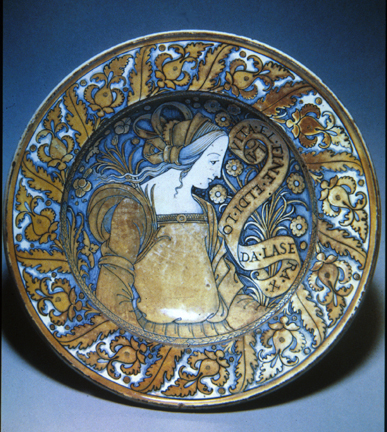Large decorative platters called 'piatti da pompa' (literally, display plates), such as this example were a speciality of the potters of Deruta, Italy. They usually have a wide, flaring rim, decorated with stylized plant motifs or scrolls. The footrings often have pierced holes so the plates could be hung on a wall. Interestingly, these holes are often misplaced, so that the plate does not hang in the proper direction. All this means is that the person who made the holes in the foot ring was not the same person as the one who would later paint it, and that sometimes that painter forgot to look at the back of the plate before he started to paint it . . . not realizing his mistake until later, when it was too late to correct. The plates are glazed with a clear lead glaze on the reverse, and an opaque 'bianchi,' or white glaze on the front. The wedding plates are most often simply painted in blue on the white background. The brown color on the plate is luster, which has faded from its original brilliant ruby color. Deruta was the first Italian center to produce lusterware in the Spanish tradition, and it was made as a direct result of Spanish imports that local Italian potters strove to duplicate. Luster ware was of great interest to the Italians since the precious metals, gold and silver, were in short supply and too costly for vessel making. The imports of 'obra de málequa' from Valencia came to be an acceptable substitute. Of such high quality was the Valencian lusterware and tile that it began to be imported into Rome for use in furnishing the papal apartments in the Vatican.The local overseer of this work was Pintoricchio, an artist from Perugia (near Deruta). Keeping his eyes open while he visited Valencian workshops and painters, he accumulated intimate knowledge of the luster process. Upon completion of the Vatican project, he returned to Deruta and set up a production center for lusterware. This dish in one example of the output of the local Deruta potters.
These plates are not considered true 'portraits,' since the facial features are rarely unique to a specific individual, but rather are thought to be 'genre' portraits, using stock images, as this same girl appears on plate after plate. The plates often incorporate verses from Latin, such as the one on this plate by Petrarch: "Life by its end, day by the evening, is praised." This is the literal translation from the Latin, but the idiomatic meaning is, "The end crowns the life; the evening, the day."

'Wedding Dish', Majolica with Luster, Deruta, 1500-1530 CE, 30" d.


